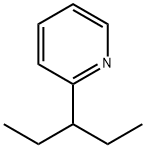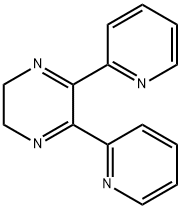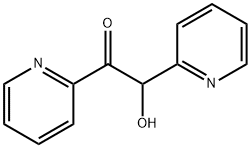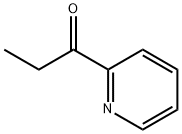2-N-PROPYLPYRIDINE
- CAS NO.:622-39-9
- Empirical Formula: C8H11N
- Molecular Weight: 121.18
- MDL number: MFCD00006368
- EINECS: 210-732-4
- SAFETY DATA SHEET (SDS)
- Update Date: 2024-12-18 13:37:16

What is 2-N-PROPYLPYRIDINE?
Occurrence
Reportedly present in beef (boiled, cooked), oat groats (toasted) and oatmeal (cooked).
The Uses of 2-N-PROPYLPYRIDINE
Traces of 2-Propylpyridine may introduce natural, green-tobacco-like, herbaceous notes in a Fougere or Chypre, particularly in conjunction with Oakmoss, Lavender, Phenylacetates, etc.
Definition
ChEBI: 2-Propylpyridine is a member of pyridines.
Production Methods
2-Propylpyridine is produced: 1) by Wolff-Kishner reduction of Propionyl pyridine. This process yields exclusively the alpha-isomer (if intermediate alpha was used). 2) from Pyridine and n-Propylbromide. This process yields a mixture of alpha- and gamma-isomers.
Aroma threshold values
Detection at 0.011 mg/m3 in air.
Properties of 2-N-PROPYLPYRIDINE
| Melting point: | 1°C |
| Boiling point: | 169-171°C |
| Density | 0,912 g/cm3 |
| refractive index | n20/D1.493 |
| FEMA | 4065 | 2-PROPYLPYRIDINE |
| Flash point: | 56°C |
| storage temp. | Inert atmosphere,Room Temperature |
| Water Solubility | Practically insoluble in water |
| form | clear liquid |
| pka | pK1:6.30(+1) (25°C) |
| color | Colorless to Light yellow |
| Odor | at 10.00 % in dipropylene glycol. green fatty roasted tobacco nutty |
| JECFA Number | 1322 |
| CAS DataBase Reference | 622-39-9(CAS DataBase Reference) |
| NIST Chemistry Reference | 2-(C3H7)-pyridine(622-39-9) |
| EPA Substance Registry System | 2-Propylpyridine (622-39-9) |
Safety information for 2-N-PROPYLPYRIDINE
| Signal word | Warning |
| Pictogram(s) |
 Flame Flammables GHS02  Exclamation Mark Irritant GHS07 |
| GHS Hazard Statements |
H226:Flammable liquids H315:Skin corrosion/irritation H319:Serious eye damage/eye irritation H335:Specific target organ toxicity, single exposure;Respiratory tract irritation |
| Precautionary Statement Codes |
P210:Keep away from heat/sparks/open flames/hot surfaces. — No smoking. P233:Keep container tightly closed. P240:Ground/bond container and receiving equipment. P261:Avoid breathing dust/fume/gas/mist/vapours/spray. P264:Wash hands thoroughly after handling. P264:Wash skin thouroughly after handling. P280:Wear protective gloves/protective clothing/eye protection/face protection. P305+P351+P338:IF IN EYES: Rinse cautiously with water for several minutes. Remove contact lenses, if present and easy to do. Continuerinsing. P370+P378:In case of fire: Use … for extinction. P403+P235:Store in a well-ventilated place. Keep cool. P501:Dispose of contents/container to..… |
Computed Descriptors for 2-N-PROPYLPYRIDINE
New Products
(S)-3-Aminobutanenitrile hydrochloride 4-Methylphenylacetic acid N-Boc-D-alaninol N-BOC-D/L-ALANINOL Tert-butyl bis(2-chloroethyl)carbamate 3-Morpholino-1-(4-nitrophenyl)-5,6-dihydropyridin- 2(1H)-one Furan-2,5-Dicarboxylic Acid Tropic acid 1-Bromo-3,5-Di-Tert-Butylbenzene S-2-CHLORO PROPIONIC ACID ETHYL ISOCYANOACETATE 2-Bromo-1,3-Bis(Dimethylamino)Trimethinium Hexafluorophosphate 4-IODO BENZOIC ACID 3-NITRO-2-METHYL ANILINE 1-(2,4-DICHLOROPHENYL) ETHANAMINE (2-Hydroxyphenyl)acetonitrile 4-Bromopyrazole 2-(Cyanocyclohexyl)acetic acid 4-methoxy-3,5-dinitropyridine 1-(4-(aminomethyl)benzyl)urea hydrochloride 2-aminopropyl benzoate hydrochloride diethyl 2-(2-((tertbutoxycarbonyl)amino) ethyl)malonate tert-butyl 4- (ureidomethyl)benzylcarbamate Ethyl-2-chloro((4-methoxyphenyl)hydrazono)acetateRelated products of tetrahydrofuran








You may like
-
 2-Propylpyridine CAS 622-39-9View Details
2-Propylpyridine CAS 622-39-9View Details
622-39-9 -
 2033-24-1 98%View Details
2033-24-1 98%View Details
2033-24-1 -
 1975-50-4 98%View Details
1975-50-4 98%View Details
1975-50-4 -
 2-HYDROXY BENZYL ALCOHOL 98%View Details
2-HYDROXY BENZYL ALCOHOL 98%View Details
90-01-7 -
 2-Chloro-1,3-Bis(Dimethylamino)Trimethinium Hexafluorophosphate 221615-75-4 98%View Details
2-Chloro-1,3-Bis(Dimethylamino)Trimethinium Hexafluorophosphate 221615-75-4 98%View Details
221615-75-4 -
 61397-56-6 CIS BROMO BENZOATE 98%View Details
61397-56-6 CIS BROMO BENZOATE 98%View Details
61397-56-6 -
 14714-50-2 (2-Hydroxyphenyl)acetonitrile 98+View Details
14714-50-2 (2-Hydroxyphenyl)acetonitrile 98+View Details
14714-50-2 -
 118753-70-1 98+View Details
118753-70-1 98+View Details
118753-70-1
Statement: All products displayed on this website are only used for non medical purposes such as industrial applications or scientific research, and cannot be used for clinical diagnosis or treatment of humans or animals. They are not medicinal or edible.